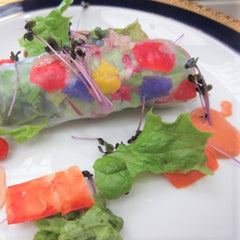![First Edible Flowers [Uzunohana] User's Guide](http://uzunohana.com/cdn/shop/articles/uzunohana02.webp?v=1692844963&width=1100)
First Edible Flowers [Uzunohana] User's Guide
Uzunohana Online has created the "Uzunohana User's Guide" for those who will be using the edible flower "Uzunohana". This guide includes basic information on "Uzunohana", recipes, and storage methods.
Index
- What are edible flowers?
- Difference between edible flowers and flowering plants and ornamental plants
- Edible flower types
- Edible flower ”Uzunohana" characteristics and reasons for choice
- How to use and store "Uzunohana"
- How to order "Uzunohana" (Japan only)
1. What are edible flowers?
Edible flowers are flowers specially cultivated for food (vegetables). Japan has a long history of using flowers for food, such as cherry blossoms, chrysanthemums, and rape blossoms. Today, the variety of these edible flowers has greatly expanded, and colorful flowers are used in many dishes and sweets, including drinks and baked goods, as well as Japanese and Western cuisine. Edible flowers, which give dishes a "color" that other ingredients cannot provide and are pleasing to the eye, go well with the recent expansion of social networking services, and are used in many hotels, restaurants, and cafes.
2. Difference between edible flowers and flowering plants and ornamental plants
What is the difference between edible flowers (flowers that can be eaten) and flowering plants and ornamental plants (flowers that cannot be eaten)? Actually, both types of flowers are the same, but they are cultivated in different ways. Edible flowers are grown with the assumption that they will be edible from the start, and either no pesticides are used or only pesticides that can be used for food (for growing edible flowers and vegetables) are used. Flowers and ornamental plants, on the other hand, are not grown for food, so pesticides that are not suitable for food are used. Of course, in this case, the pesticides used are also "inedible" and not dangerous for "ornamental" use. Flowering seedlings sold at home improvement stores are generally grown for "ornamental" use, so you cannot buy these seedlings and grow them for "edible" use.
In addition, some flowers, such as hydrangeas, daffodils, and lily of the valley, are known to be toxic, and of course these flowers are not edible. Thus, edible flowers are those that have been grown safely for food from the beginning and can be eaten with the same confidence as other vegetables.
3. Edible flower types
Some examples of flowers commonly used as edible flowers include the following [1].
Rose, lavender, German chamomile, hibiscus, carnation, calendula, chrysanthemum, cornflower, cosmos, cherry blossom, snapdragon, dianthus, torenia, nasturtium, pansy, viola, begonia
Among these flowers, Uzunohana Online offers the following edible flowers.
 |
 |
 |
 |
| Pansy, Viola | Dianthus | Cornflower | Begonia |
4. Edible flower ”Uzunohana" characteristics and reasons for choice
What are the characteristics of the edible flower "Uzunohana"? It is that Uzunohana is a product that places the greatest emphasis on the stable supply of fresh and beautiful flowers at any time of the year, in small lots, throughout the country. Uzunohana's fresh flowers are grown hydroponically in a clean room. Therefore, the flowers are available at any time of the year, regardless of the blooming season. Also, since the flowers are packaged fresh after harvest and delivered in small packages nationwide, they can be used from a single pack even in areas where it is difficult to obtain edible flowers. Fresh flowers "Uzunohana" are shipped in packs of 40 flowers per pack not only to major metropolitan areas but also from Hokkaido to Okinawa in Japan, and approximately 200,000 flowers are shipped annually[2].
 |
 |
5. How to use and store "Uzunohana"
"Uzunohana" can be used raw as well as leafy greens for salads. It can be used as a garnish for salads and hors d'oeuvres, or hardened in jellies and puddings.
 |
 |
 |
 |
 |
 |
Because "Uzumi-no-Hana" fresh flowers are real flowers, they are susceptible to drying out and will easily wilt if left at room temperature. When storing, moisten the water-retaining sheet at the bottom of the pack thoroughly, seal the pack tightly, and store in the refrigerator. Once frozen, they will be damaged when thawed, so avoid places where they are prone to freezing, such as near cold air vents in the refrigerator, and store in a non-freezing place, such as a vegetable room if possible.
If the product is not opened and refrigerated (5°C) immediately after arrival, it can be stored for up to one week.
6. How to order "Uzunohana" (Japan only)
"Uzunohana" can be purchased directly at our online site below.
Uzunohana Online
|
Uzunohana Online
|
Uzunohana Online
|
[1] 小松美枝子. Mieko's Garden Edible Flower Life ー食べる花のある生活ー. 東京, キラジェンヌ株式会社. 2018, 107-120p.
[2]2022年7月~2023年6月実績


